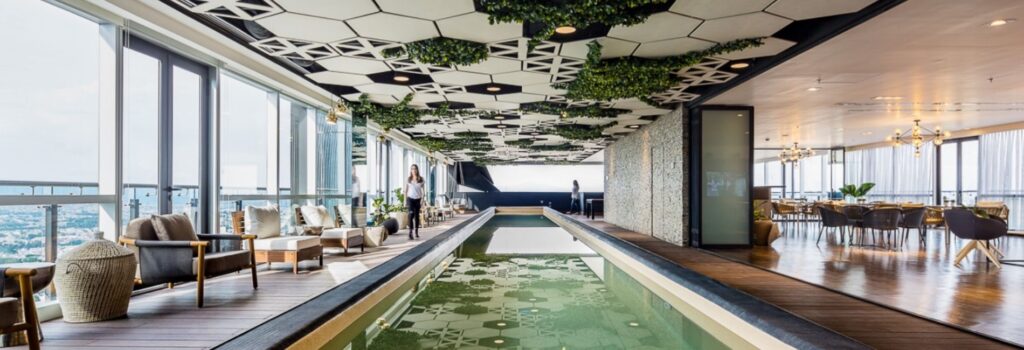As published in Connected Real Estate Magazine for the Summer Issue
As the commercial real estate industry grapples with the blended work environment, it has become clear that top-tier indoor connectivity is no longer a nice-to-have. For buildings vying to attract tenants into empty office spaces and companies looking to make offices more productive than at-home alternatives, this connectivity is essential.
For many, the shortcomings of WiFi — including its security failings, lack of accountability for performance, and high levels of interference — render it untenable as a scalable solution. Mobile-first solutions like distributed antenna systems (DAS) are the ideal alternative. DAS provides a dedicated wireless network via a system of small antennas connected by fiber-optic cables. These emit a high-quality signal tailored to the needs of that space, ensuring every corner receives perfect cellular signal; the right setup will even enable 5G. Yet DAS to date has been prohibitively expensive. Network carriers typically financed these solutions, but these projects have taken a backseat as carriers focus the majority of their investments on expanding outdoor networks. Few venues can afford the hefty upfront Capex of a DAS, resulting in a scaled-down design, an inadequate “booster” system or an expensive, stalled project with a traditional third-party operator. Meanwhile, tenants struggle to connect to mobile networks indoors and can’t find buildings with adequate connectivity for modern business needs.

QMC Telecom recognized this challenge. As a third-party operator with deep experience implementing DAS solutions across the Americas, QMC functions as a neutral host between venues, network carriers and technology providers. That role enabled QMC to pinpoint the core issue limiting the potential of DAS technology: though connectivity is top-of mind for today’s tenants, CRE professionals do not have enough options or control to implement that connectivity.
To help buildings address this challenge, QMC designed and rolled out an entirely new model of venue-led DAS implementation, based on market collaboration, flexible financing, Day 1 coverage by the carriers, and service guarantees over the lifetime of the DAS.
According to George Malkin, QMC’s Head of US Launch, “Our model is a complete paradigm shift for the industry: we deliver the benefits of neutral host DAS without any of the friction that you typically see in 3PO models.” Traditional DAS deployments — whether orchestrated by a carrier or by a third-party operator — are funded, designed, scoped and controlled by the network carrier. Consequently, they are only available to large venues, often extend on long timelines and are limited in scope with no consideration of the building’s priorities. The venue also may struggle to get all three major carriers on their DAS, since one carrier may build the DAS to suit their needs alone.
By contrast, venue-led deployments are under the full control of the building. The QMC model is designed to address the primary shortcomings of traditional deployments by empowering venues within DAS partnerships. For example, a typical 3PO-led project includes 18-24 months of speculative exclusivity while the 3PO searches for funding and a willing carrier partner; that funding partner then dictates the DAS layout. A venue-led project cuts out all that time, gets implemented on both the carrier and the venue’s terms and is still fully managed by an experienced 3PO.
This partnership approach also enables the venue to control the way the system is designed and put the needs of tenants first. Through its flexible financing model, QMC transforms the upfront Capex of the DAS into ongoing Opex and bears the risk of the DAS’s performance over a decade. QMC also coordinates long-term maintenance for a true managed service, from technology upgrades to the human expense of coordinating with all the carriers and vendors.
Malkin emphasized the benefits to CRE stakeholders: “In this model, the venue doesn’t have to worry about keeping the DAS current with upgrades or maintaining service-level quality. It’s just another line item in the building’s P&L.”

QMC AND GREYSTAR PARTNER ON VENUE-LED DAS
The venue-led DAS model has already seen noteworthy success, most recently in QMC’s partnership with Greystar Real Estate Partners (“Greystar”), the global leader in rental housing, at their Stratto Americas location in Guadalajara, Mexico.
A collection of 230 rental apartments across 12 floors, the highly amenitized development includes a game center, business center, swimming pool and jacuzzi, barbecue, sports bar, gym, restaurants, reading corner, and wellness area. Yet upon completion of the development, none of these locations received adequate cell service, which posed an operational challenge to Stratto’s residential experience. To bring complete indoor cellular coverage to an existing building, Greystar realized that DAS was the ideal solution. After failing to obtain any carrier funding, Greystar reached out to QMC, a proven provider with over a decade of regional experience as a third-party operator.
As that neutral third party, QMC was responsible for the end-to-end DAS deployment. However, this project was entirely venue-led; the Stratto Americas team chose how and when to insert its wireless network service, with QMC relaying these specifications to the relevant carriers and technology vendors. This solution was deployed as a longterm financial partnership, meaning QMC shouldered upfront costs, while Greystar will continue to pay back the DAS over the long term. Ultimately, the joint teams designed a DAS that distributes the signal source of network carriers across 220,600 square feet via 84 connected antennas, ensuring cutting-edge connectivity for guests and visitors alike.
Because QMC provides an ongoing, managed service, QMC continues to actively monitor the DAS via its Network Operation Center (NOC) 24 hours a day, 7 days a week to ensure prompt issue resolution as needed. According to Ricardo Amack, Mexico country leader for Greystar, “Mobile connectivity was a top priority for our residents and a major challenge to the project — we were not willing to compromise when it comes to indoor connectivity. DAS technology gives our Stratto project a considerable improvement on cell signal throughout our residential units and our amenities. Without the partnership and innovative model of QMC, DAS would have been out of reach.”
While Greystar’s Stratto Americas is a residential project, QMC Telecom is also leveraging the venue-led DAS model to transform commercial real estate buildings across North America. Its implications are significant: what was once a technology deployed at the whim of giant network carriers is now available for any and all venues looking to upgrade their connectivity and serve the standards of modern commercial tenants.
Particularly as businesses design offices around the concept of hybrid work, networks that deliver private, fast, reliable connections will become a primary selling point. Those attractive features are vital with an overabundance of empty office spaces on the market. As Malkin concludes, “To get workers back into the office, we need to prove that office work is more productive than work at home. Connectivity is essential to delivering that productivity, and that’s why we truly believe in making DAS accessible and bringing it to all venues.”






